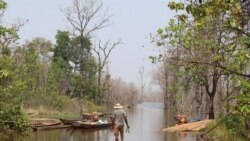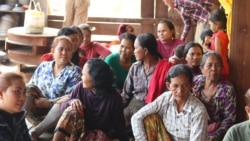A Ministry of Energy official said Tuesday that Cambodia will not develop new mainstream hydropower projects on the Mekong River for the next 10 years.
Villagers and fishing communities along the Mekong River long have been in the dark over whether proposed dams, including the massive 2,600 megawatt Sambor Dam in Kratie province, would proceed as planned and compound challenges already faced by communities and tens of thousands of Cambodians along the river.
Victor Jona, a spokesman of the Ministry of Mines and Energy, said the new master plan for Cambodia’s energy needs included no planned dam construction along mainstream Mekong River for the next decade.
“Between 2020 to 2030, we will not develop any dams on the Mekong mainstream,” he told VOA Khmer on Tuesday, declining to share the new masterplan.
He added the ministry would conduct a “comprehensive study” and environmental impact assessment before deciding on new dam construction along the mainstream.
However, Victor Jona also said the Cambodian government will study the potential construction of small- and medium-sized dams on Mekong tributaries and other sources of water. He said the state will further study the possible use of liquefied natural gas, with a project planned with Chinese firm CNOOC Gas Power Group Co Ltd expected to be online in 2027.
Environmental groups have long criticized the rapid construction of large hydropower dams along the Mekong River, most recently pointing to the planned 1,460MW Luang Prabang dam in Laos.
These dams, groups say, have disrupted riverine culture among communities living along the river, negatively affected fish populations and more recently obstructed flow of sediment, with parts of the Mekong seeing crystal clear waters. The seasonal flow of sediment generally is important to sustaining fertile farmlands near the river.
According to documents submitted to the Mekong River Commission in 2018, Cambodia sees 10,000 MW of potential power generation in the river, 50 percent of which would come from the mainstream.
Phloak Sareth, a 49-year-old mother of five, lives here in Boeung Char commune in Kratie province on Tnaut Island in the Mekong River. She told VOA Khmer that her family and nearby villagers live in uncertainty about the planned Sambor dam. Local residents remain concerned about their possible displacement.
“Here, it is good to live,'' Phloak Sareth said. ''We don’t know whether the new place is better or not and if the land is good for crops or not.”
She explained that the water level had become irregular and the quantity and quality of available fish in the river already had decreased.
According to the U.S.-based environmental organization, International Rivers, “the Sambor Dam would be a tragic and costly mistake for Cambodia.”
“If built, the Sambor Dam would block major fish migrations between Southern Laos and Cambodia’s Tonle Sap Lake, destroy critical deep pool fish habitats, and interrupt the river’s hydrological, sediment and nutrient cycles, impacting the river’s wider ecology,” International Rivers says on its website.
Up river to the north, Laos is also building or planning to start construction on controversial dams along the Mekong, including the Xayaburi and Don Sahong near the border with Cambodia.
In February, five Cambodian NGOs —3S River Protection Network, FACT, The NGO Forum on Cambodia, My Village, Center and Environment Preservation Association – raised concerns over a planned hydropower dam in Luang Prabang, Laos, pointing to the potential effects on water flow, fish populations and sediment transfer to the lower Mekong.
The groups said that the new project, along with existing hydropower dams, would affect the hydrology of the lower Mekong, especially the Tonle Sap Lake, which is critical to most Cambodians, who rely on it for food.










